Irrigation Management
 Irrigation Management
Irrigation Management
 Drip Irrigation
Drip Irrigation
 Installation
Installation
 Water Requirement
Water Requirement
 Cost of Cultivation
Cost of Cultivation
 Problems and Remedies
Problems and Remedies
 Fertigation
Fertigation
 Fertigation Equipments
Fertigation Equipments
Irrigation Management
-
The total water requirement of banana plants is about 900-1200 mm for its entire life cycle and this can be met both through natural precipitation (rainfall) as well as supplementary irrigation.
-
Maintaining optimum moisture at all stages of growth is very critical and providing good drainage facility to drain out excess water from the root zone equally important to promote better growth and enhance the productivity.
-
In general, irrigation of the banana plantations every 3- 4 days during hot period and at 7-8 days interval during cool weather is recommended.
-
In banana plantations different systems of irrigation is in practice and each system has its own merits and demerits. They are
-
Flood or Furrow irrigation, Trench irrigation, Drip Irrigation and Fertigation.
-
Flood or Furrow irrigation is the most common method of irrigation under garden land cultivation. In this system the water consumption is very high and is costly, with uneven distribution of water and fertilizers. There is a chance for fast spread of nematodes
-
Trench irrigation is a popular method of irrigation under wet land system of cultivation where in the water is allowed to stand in the trenches opened between every two rows of plants and the same is used for draining out the excess water during rainy days.
Drip Irrigation
Drip irrigation is the method of applying uniform and precise amount of water directly to the root zone of the plants as per the requirement,through emitters at frequent intervals over a long period of time,via a low-pressure pipe network comprising of mains,submains and laterals. Principles: Drip irrigation is the most scientific method of irrigation which has the following features:
|
Components
Head Equipments
-
Water source subsurface tank
-
Pump
-
Filters
Distribution System
-
Mainline
-
Submains
-
Laterals
-
Emitters / Drippers
Head Equipments
Water source subsurface tank :
|
 |
Pump:
|
 |
Filters
1) Gravel or Media Filter: Media filters consist of fine gravel or coarse quartz sand, of selected sizes (usually 1.5 – 4 mm in diameter) free of calcium carbonate placed in a cylindrical tank. These filters are effective in |
2) Screen Filters: Screen filters are always installed for final filtration as an additional safeguard against clogging. |
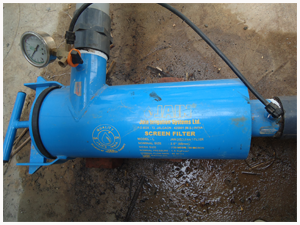 |
3) Centrifugal filters Centrifugal filters are effective in filtering sand, fine gravel and other high density materials from well or river water. Water is introduced tangentially at the of a cone and creates a circular motion resulting in a centrifugal force, which throws the heavy suspended particles against the walls. |
4) Disk Filters Disk filter contains stacks of grooved, ring shaped disks that capture debris and are very effective in the filtration of organic material and algae. During the filtration mode, the disks are pressed together. |
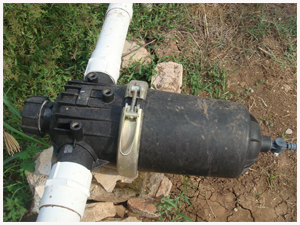 |
Distribution System:
Mainline The mainline transports water within the field and distribute to submains. Mainline is made of rigid PVC and High Density Polyethylene(HDPE). Pipelines of 65 mm diameter and above with a pressure rating 4 to 6 kg/cm2 are used for main pipes. |
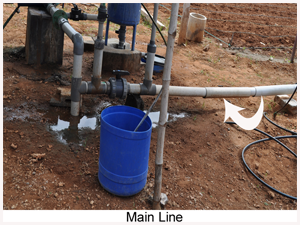 |
Submains: Submains distribute water evenly to a number of lateral lines. For sub main pipes, rigid PVC, HDPE or LDPE (Low Density Polyethylene) of diameter ranging from 32 mm to 75 mm having pressure rating of 2.5 kg/cm2 are used. |
Laterals : Laterals distribute the water uniformly along their length by means of drippers or emitters. These are normally manufactured from LDPE and LLDPE. Generally pipes having 10, 12 and 16 mm internal diameter with wall thickness varying from 1 to 3 mm are used as laterals. |
Emitters / Drippers: They function as energy dissipaters, reducing the inlet pressure head (0.5 to 1.5 atmospheres) to zero atmospheres at the outlet. The commonly used drippers are online pressure compensating or online non-pressure compensating, in-line dripper, adjustable discharge type drippers, vortex type drippers and micro tubing of 1 to 4 mm diameter. These are manufactured from Poly- propylene or LLDPE. |
 |
Installation
Installation of Head Equipments
The following points should be considered for fixing the position of filtern station
|
Connecting Mains And Sub mains:
|
Laying of Laterals and drippers:
|
Water Requirement
Month |
Water Req. Lit/Day/Plant |
Month |
Water Req. Lit/Day/Plant |
June |
5-6 |
October |
4-6 |
July |
4-5 |
November |
4-6 |
August |
5-6 |
December |
4-6 |
September |
6-8 |
January |
8-10 |
October |
10-12 |
Febraury |
10-12 |
November |
8-10 |
March |
16-18 |
December |
6-8 |
April |
18-20 |
January |
10-12 |
May |
20-22 |
Febraury |
12-14 |
June |
20-22 |
March |
16-18 |
July |
10-12 |
April |
20-22 |
August |
12-14 |
May |
25-30 |
September |
14-16 |
Cost of Cultivation
Area |
1 ha, planting geometry:2m*2m |
Fixed cost of drip system |
Rs.60,700 |
Area interest rate |
10.5% |
Life of system |
7.5 years |
Annual cost of drip |
Rs.17,456 |
Cost of cultivation |
Rs.30,000 |
Expected yield |
47 t/ha |
Expected benefit cost ratio |
4.5 |
12 mm Lateral Pipe - Rs. 3.75/m. |
Dummy - Rs. 0.30 each |
Problems and Remedies
|
|
|
|
Leakage of water at the joint between sub main and lateral |
Damaged joints. |
Correct damages. |
|
Leakage in the poly tube. |
Damage of polytube by farming activities/rat. |
Block the holes by goof plug. use poly joiners at cuts. |
|
Water not flowing upto lateral end. |
Holes in laterals. cuts in laterals. bents in laterals. |
Close the holes and cuts. remove the bends. |
|
Out coming of white mixture on removing the end plug. |
More salinity in water. uncleaned lateral. |
Remove the end stop. clean the laterals fortnightly. |
|
Under flow or over flow from laterals. |
Clogging of drippers. unclosed end plug. |
Clean the sand and screen filters. close the end cap. |
|
Oily gum material comes out on opening the lateral end. |
More algae or ferrous material in water. |
Clean the laterals with water or give chemical treatment. |
|
More pressure drop in filters |
Accumulation of dirt in filters |
Clean filters every week. Back wash the filters for every 5 minutes daily. |
|
Pressure gauge not working. |
Rain water entry inside. corrosion in gauge pointer damage. |
Provide plastic cover and fix pointer properly. |
|
Drop in pressure |
Leakage in main opened outlet. low water level in well. |
Arrest the leakege and close outlet. lower the pump with reference to well water level. |
|
More pressure at the entry of sand filter. |
No bypass in the pipeline/bypass not opened. displacement of filter element. less quantity of sand in filters. |
Provide bypass before filter and regulate pressure. place filter element properly. fill required quantity of sand. |
|
Accumulation of sand and debris in screen filter |
Displacement of filter element.Less quantity of sand in filters. |
Place filter element prpoperly.Fill required quantity of sand |
|
Ventury not working during chemical tratment and fertigation |
Excess pressure on filters improper fitting of ventury assembly |
Bypass extra water to reduce pressure repair the ventury assembly |
|
Leakage of water from air release valve |
Damaged air release valve ring |
Replace the damaged ring |
Merits:
|
Demerits
|
Fertigation
Fertigation
|
WATER SOLUBLE FERTILIZERS (WSF):
Water Soluble Fertilizers are fully water-soluble solid fertilizers having high content of primary nutrients with low salt index. They may or may not have Secondary/micro-nutrients. These water-soluble fertilizers can be advantageously utilized for foliar feeding and Nutrigation / fertigation, thus helping in precision agriculture. |
Choice of fertilizers:
Element |
Fertilizer |
Limitation |
Nitrogen |
Liquid Ammonium nitrate |
None |
Ammonium sulphate |
To be avoided in uses of water having Ca > 70 ppm |
|
Urea |
None |
|
Phosphorus |
Super phosphate water |
Colloidal particles well screened |
Phosphoric acid |
Very dilute solution |
|
Potassium |
Liquid potassium nitrate |
None |
|
Liquid potassium chloride |
Avoid when water contain high chloride >300 ppm |
Iron, Zinc |
Chelated compound |
none |
Fertilization
-
Nitrogen Fertilisation
-
Phosphorus Fertilization
-
Potassium Fertilization
Nitrogen Fertilization
|
PHOSPHORUS FERTILISATION
|
WATER QUALITY INTERACTION WITH P
|
POTASSIUM FERTILIZATION
|
Fertigation Scheduling
General Weekly Fertigation Schedule for Banana (g/ plant / application)
|
|
|
|
|
9 to 18 week(10 weeks) |
15 |
150 |
8.0 |
80 |
19 to 30 week(12 weeks) |
10 |
120 |
10 |
120 |
31 to 40 week(10 weeks) |
7.0 |
70 |
12 |
120 |
41 to 46 week(5 weeks) |
Nil |
Nil |
10 |
50 |
Total |
---- |
340 |
---- |
375 |
Schedule of application of fertilizers through drip for Banana
Total quantity of fertilizer required per acre.

Schedule of solid fertilizer

Water Soluble Solid Fertilizer :

Schedule For Water Soluble Solid Fertilizer

Fertigation schedule for banana variety grand naine
Recommended dose: 200:35:300 g NPK per plant
100 % of TRD as WSF: 635: 111.13: 953 Kg N: P: K per ha
Spacing: 1.5 X 2.1 m (3175 plants per ha)
Sl. No. |
Crop Stage |
Duration |
Fertilizer grade |
Total fertilizer |
1 |
Establishment stage |
9 -18 weeks(10 weeks) |
13-0-45 |
423.13 |
2 |
Vegetative stage |
19 – 30 weeks(12 weeks) |
13-0-45 |
846.26 |
3 |
Shooting stage |
31 - 42 weeks(12 weeks) |
Urea |
275.60 |
4 |
Development and harvesting stage |
43 - 45 weeks(3 weeks) |
0:0:50 |
152.48 |
P- applied as basal at second month after planting as SSP 111.13 x 6.25 = 695 kg per ha
Fertigation schedule for banana variety- Poovan, Robuta and Dwarf Cavendish
Recommended dose: 100:35:330 g NPK per plant 100 % of TRD as WSF: 317.5:1047.75 Kg N: K per ha .Spacing: 1.5 X 2.1 m (3175 plants per ha)
Sl. No. |
Crop Stage |
Duration |
Fertilizer grade |
Total fertilizer (Kg per ha) |
1 |
Establishment stage |
9 -18 weeks(10 weeks) |
13- 0- 45 |
465.20 |
2 |
Vegetative stage |
19 – 30 weeks(12 weeks) |
13- 0- 45 |
930.40 |
3 |
Shooting stage |
31 - 42 weeks(12 weeks) |
Urea |
137.80 |
4 |
Development and harvesting stage |
43 - 45 weeks(3 weeks) |
0:0:50 |
167.64 |
‘P- applied as basal at second month after planting as SSP 111.13 x 6.25 = 695 kg per ha
Fertigation schedule for banana variety Nendran
Recommended dose: 150:90:300 g NPK per plant 100 % of TRD as WSF: 476.25: 953.00 Kg N: K per ha. Spacing: 1.5 X 2.1 m (3175 plants per ha)
Sl. No. |
Crop Stage |
Duration |
Fertilizer grade |
Total fertilizer (Kg per ha) |
1 |
Establishment stage |
9 -18 weeks(10 weeks) |
13 -0- 45 |
423.13 |
2 |
Vegetative stage |
19 – 30 weeks (12 weeks) |
13- 0- 45 |
846.26 |
3 |
Shooting stage |
31 - 42 weeks(12 weeks) |
Urea |
609.92 |
4 |
Development and harvesting stage |
43 - 45 weeks(3 weeks) |
0:0:50 |
152.48 |
‘P- applied as basal at second month after planting as SSP 90 X 317 X 6.25 = 1785.94 kg per ha
Fertigation Methods
Methods of fertigation:
Injection of fertilizer and other agrochemicals such as herbicides and pesticides into the drip irrigation system is done by
-
By-pass pressure tank
-
Venturi system and
-
Direct injection system.
(i) By-pass pressure tank:
|
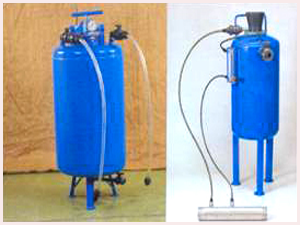 |
(ii) Venturi Injector:
|
 |
(iii) Direct injection system:
|
 |
Fertigation Equipments
Water soluble fertilizers can be injected through
-
Ventury Injector
-
Fertilizer Tank
-
Injector Pump
-
Automatic Fertigation Controller
-
External energy driven injector pumps
Ventury Injector
This is very simple and low cost device. A partial vacuum is created in the system which allows suction of the fertilizers into the irrigation system through a constriction which increase the velocity of flow thus creating a drop in pressure. When the pressure drops the fertilizer solution is sucked into the ventury through a suction pipe from the tank and from the enters into irrigation stream. Although simple and with greater uniformity of dosing than fertilizer tank the ventury cause a high pressure loss in the system which may result in uneven water & fertilizer distribution in the field. The suction rate of ventury is 30 to 120 lit. per hour. |
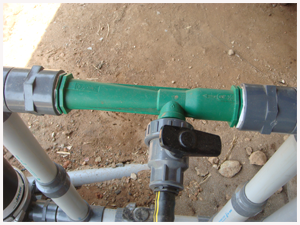 |
Fertilizer Tank
In this system part of irrigation water is diverted from the main line to flow through a tank containing the fertilizer in a fluid or soluble solid form, before returning to the main line, the pressure in the tank and the main line is the same but a slight drip in pressure is created between the off take and return pipes for the tank by means of pressure reducing valve. This causes water from main line to flow through the tank causing dilution and flow of the diluted fertilizer into the irrigation stream. With this system the concentration of the fertilizer entering the irrigation water charges continuously with the time, starting at high concentration. As a result uniformity of fertilizer distribution can be problem. Fertilizer tanks are available in 90,120,160 liters capacity. |
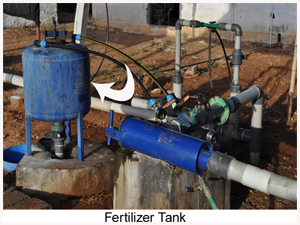 |
Fertilizer Injector Pump
These are piston or diaphragm pumps which are driven by the water pressure of the irrigation system and such as the injection rate is proportional to the low of water in the system. A high degree of control over the fertilizer injection rate is possible, no serious head losses are incurred and operating cost are low. Another advantage is that if the flow of water stops. Fertilizer infection also automatically stops. This is perfect equipment for accurate fertigation. Suction rates of pumps varies from 40 lit to 160 lit per hour. |
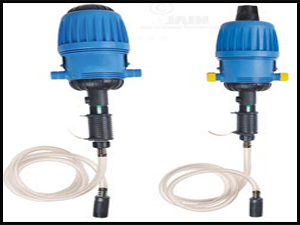 |
Automatic Fertigation Controller
Automatic fertigation control system are installed for proper fertilization controlling. the following are the advantages of installing an automatic system:
|
 |
CRITERIA FOR APPLYING FERTILISERS
|
Merits
|
Demerits
|
